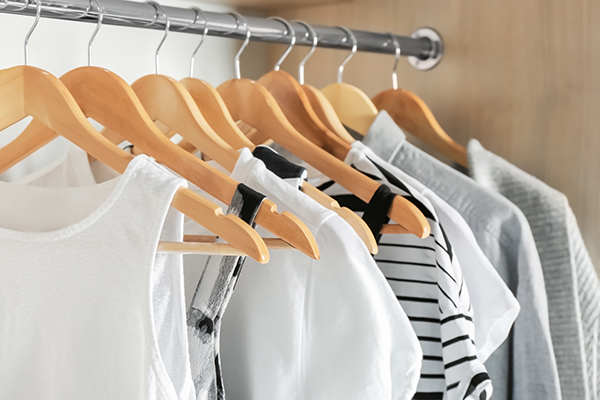Here’s the Right Shelf and Closet Rod Height
Organizing your closet isn’t possible without setting up the shelves and rods at the correct heights. You might think it’s a small detail, but it makes a big difference. The right shelf and closet rod height helps you use your closet space better, makes things easier to reach, and keeps everything tidy. Whether you’re giving your closet a makeover or just improving it, understanding how to get the shelves and rods right is crucial. In this blog post, we’ll share Taskers’ top tips on how to figure out the perfect heights for your closet shelves and rods so you can have a stylish and efficient storage space.
Consider This When Determining Closet Rod Height
When deciding the height of your closet rod, think about these important factors:
Type of Clothing
Different clothes need different heights. Suits, blouses, and t-shirts have varying storage needs. For example, you might want double rods to hang both short and long clothes.
Accessibility
Make sure the rod is at a height where you can easily reach your everyday clothes. Save the middle and eye-level spaces for the stuff you use the most to make your daily routine smoother.
Storage Needs
Think about what you want to store. If you have lots of shoes, bags, or folded clothes, consider adding shelves or extra rods at different heights to maximize your storage space.
User Height
Adjust the rod height to fit the people who will use the closet the most. Adults and children may need different heights.
Aesthetics and Design
Make sure the rod placement looks good and matches your closet’s design. It should be both functional and stylish.
Future Changes
Think about how your wardrobe might change over time. Leave some room to adjust the rod height as your clothing collection evolves.
Closet Rod Distance from Wall
You’ll want to make sure your closet rod is spaced far enough away from the wall to fit standard and XL-size hangers with a few inches to spare.
Considering these factors when setting your closet rod height and closet rod distance from the wall will help you create a user-friendly, well-organized space perfect for YOUR needs!
Standard Closet Rod Height
There are two standard closet rod heights to consider:
Single Rod Height
A single rod is the basic setup. The standard height for a single closet rod is typically around 66 inches (5 feet 6 inches) from the floor to the middle of the rod. This height works for hanging most clothes, like shirts, blouses, and pants.
Double Rod Height
Double rods are great for maximizing storage. They have two rods, one above the other. For double closet rod height:
- Upper Rod Height: The top rod is usually set at about 80 inches (6 feet 8 inches) from the floor to the center of the rod. This is perfect for shirts and blouses.
- Lower Rod Height: The lower rod sits at approximately 40 inches (3 feet 4 inches) from the floor to the center of the rod, ideal for pants, skirts, and shorter items.
Following these standard closet rod heights helps you create a closet that uses space efficiently and keeps your clothes easily accessible.
Standard Closet Shelf Height
Shelves in a closet are usually spaced about 12 to 16 inches apart vertically. This arrangement lets you store folded clothes, shoes, and other items neatly while allowing for different item heights. Typically, the top shelf is set higher, at least 80 inches (6 feet 8 inches) from the floor, to make the most of the vertical space and store items you don’t need every day. You can adjust the exact height of the closet rod within this range to match your specific storage needs, but sticking to these general guidelines ensures a well-balanced and adaptable closet setup.
Need Mounting Help?
If you’re working on your closet but need some help with mounting shelves and rods, Taskers are here for you! By hiring a Tasker through Taskrabbit, you can benefit from the skills of someone with experience who can accurately measure, mount, and install your closet components, so they are level, secure, and perfectly aligned.
Why Hire a Tasker for Closet Mounting Services?
- Expertise: Taskers have experience and know how to secure shelves and closet rods safely and effectively.
- Time-Saving: Taskers work efficiently, saving you time and frustration compared to DIY installations.
- Customization: Taskers can tailor your closet layout to your specific needs and preferences, ensuring the perfect height and spacing for your wardrobe.
- Safety: Properly installed shelves and rods reduce the risk of accidents and damage to your belongings.
- Convenience: Taskers are available when you need them, and they bring the necessary tools and equipment, so you can relax while they get the job done.
Ready to turn your closet into an organized paradise? Don’t miss the chance to optimize your closet space–book a Tasker now and take the first step toward a clutter-free and perfectly organized closet!
FAQ About Closet Rods
What Is The Proper Height For a Closet Rod?
The proper height for a closet rod typically depends on factors like the types of clothes you have. For most closets, a good height for a single rod is around 66 inches from the floor, which is about 5 feet and 6 inches. But if you have longer items like dresses or coats, you might want to hang the rod higher to prevent them from touching the floor.
What is the Height of the Entry Coat Closet Rod?
The height of the entry coat closet rod is usually around the same as a regular closet rod, which is about 66 inches from the floor. This height works well for hanging coats and jackets.
How Long Can a Closet Rod be Without Support?
A closet rod can be about 4 to 5 feet long without needing additional support in the middle. But if you have a longer rod, like 8 feet, it’s a good idea to use a center support bracket to prevent sagging in the middle.
Is a Wood or Metal Closet Rod Better?
Whether a wood or metal closet rod is better depends on your preference and the look you want for your closet. Wood rods can add a more traditional or warm feel, while metal rods tend to be sturdier and may fit a more modern style. Both materials can work well, so it’s a matter of personal choice.














